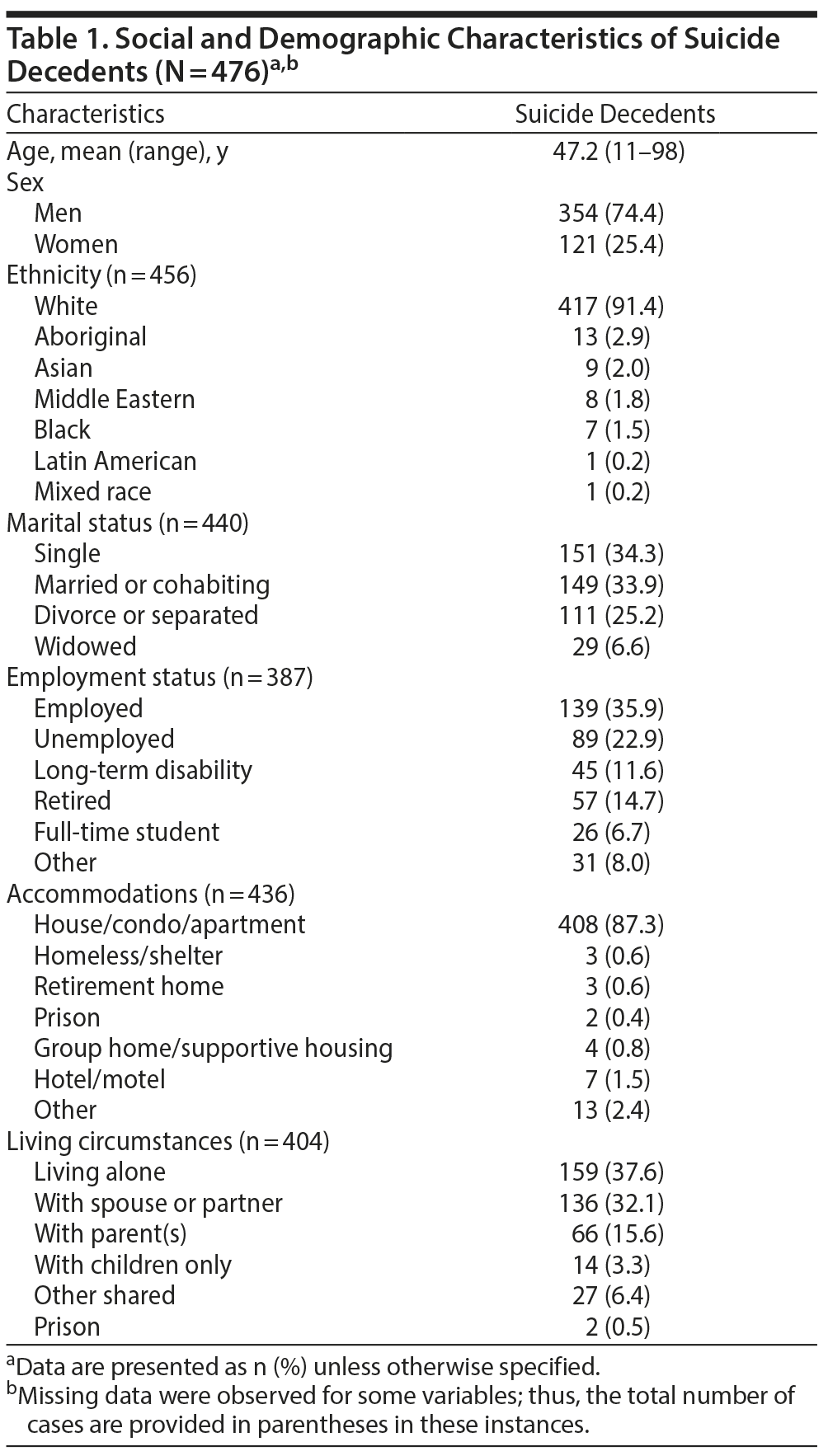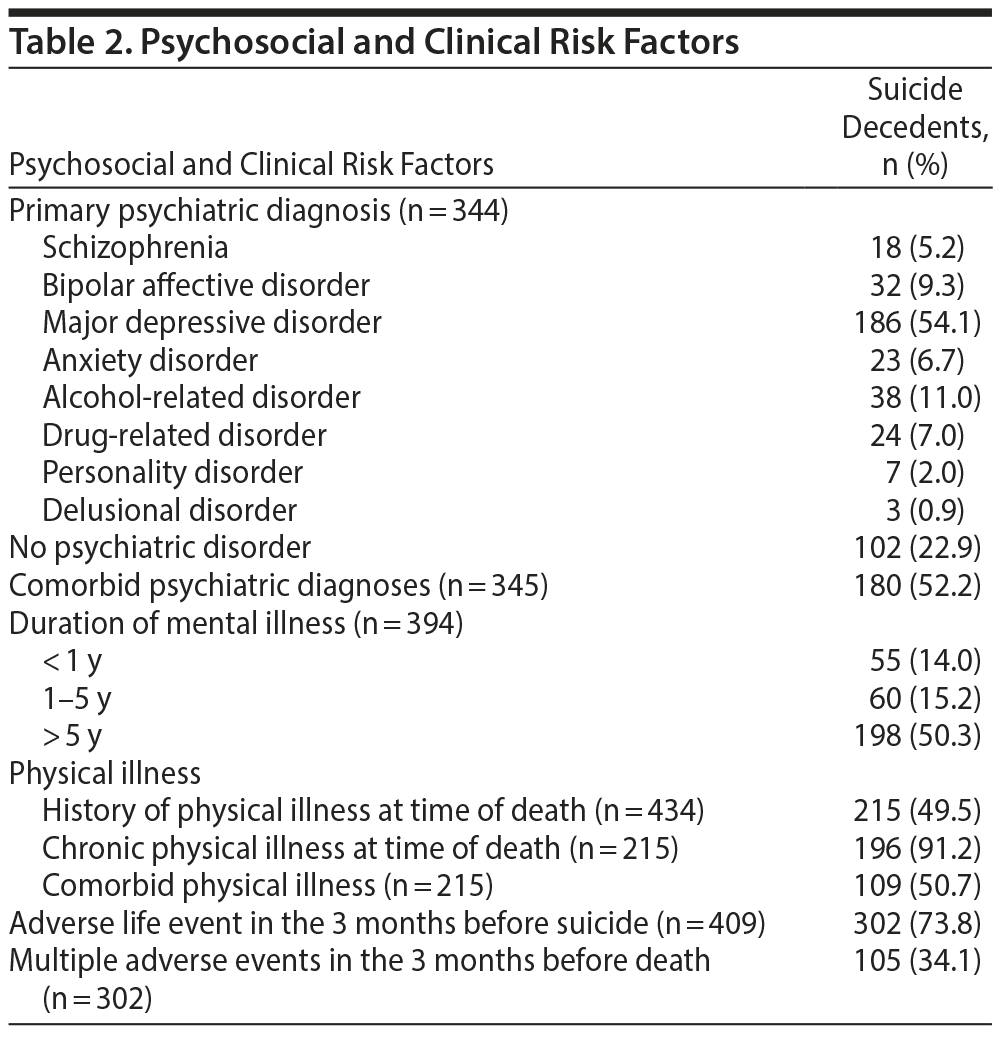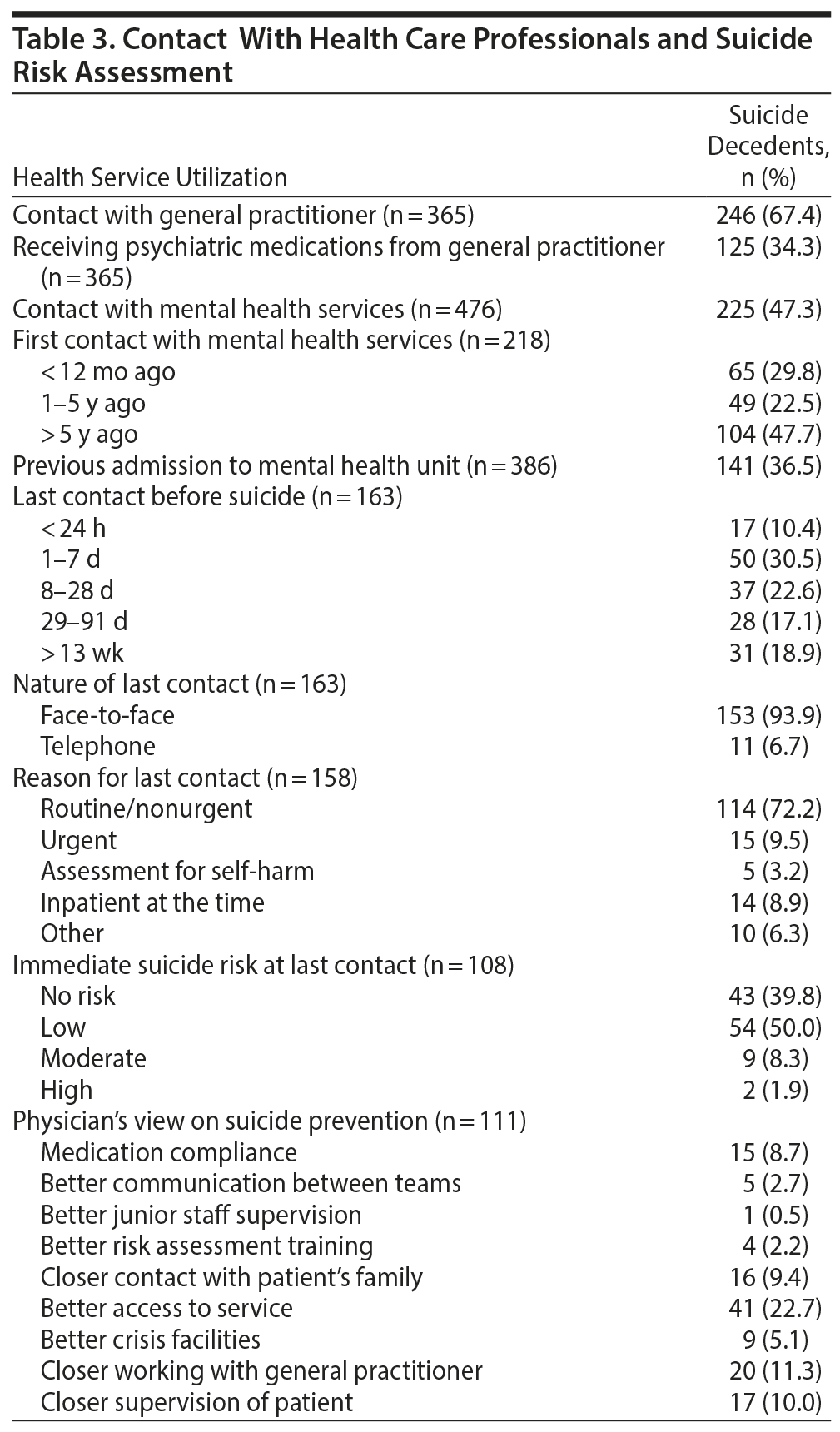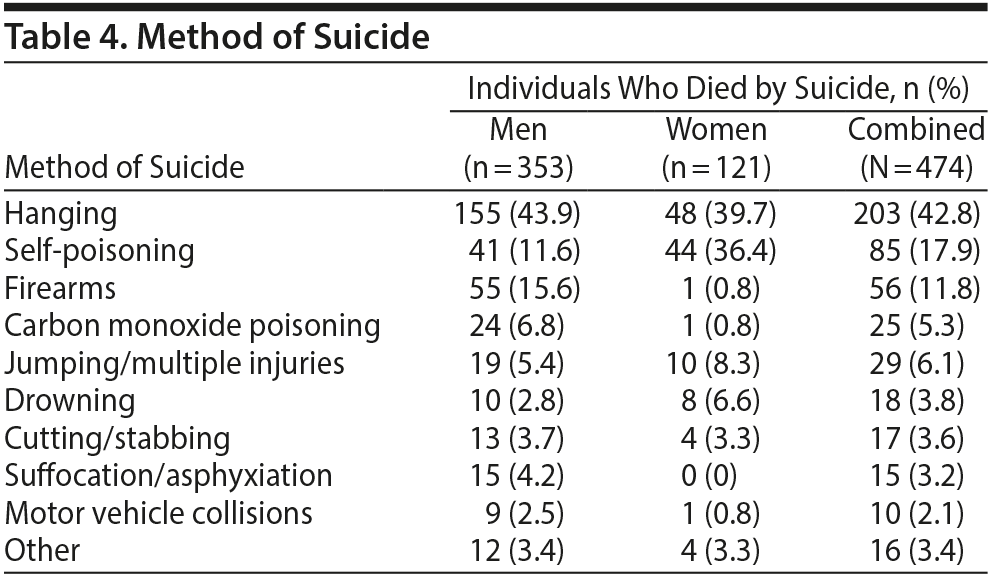Objective: To describe sociodemographic and clinical characteristics of suicide decedents and to explore the pattern of clinical and suicide risk assessment in primary care settings.
Methods: A 3-year case series of consecutive suicides (January 1, 2012, to December 31, 2014) in Southwestern Ontario, Canada, identified by the Office of the Chief Coroner of Ontario and Ontario Forensic Pathology Service (OCC/OFPS) was conducted. Clinicians who provided care to suicide decedents completed a confidential suicide questionnaire offered online through a secured portal or by hardcopy.
Results: A total of 476 suicide cases were analyzed using data extracted from the OCC/OFPS files or provided by clinicians who had completed the survey. Hanging (42.8%) was the most common method of suicide, followed by self-poisoning (17.9%). More than half of the decedents (51.8%) used psychotropic medications, and 29.4% used opiates to self-poison. Typically, these self-poisonings involved prescribed medications (70.6%). Over two-thirds (67.4%) of suicide decedents had consulted their primary care physician prior to their deaths, and 63.6% had been seen by a physician within 28 days of their death. Suicide risk assessments were reportedly conducted in 87.1% of these visits. Of those who were assessed, the immediate risk of suicide was deemed to be absent in 39.8%, low in 50.0%, moderate in 8.3%, and high in only 1.9%.
Conclusion: The findings from this confidential survey may be important for the formulation of recommendations that could improve suicide prevention in primary care practice.
Confidential Survey Into Southwestern Ontario Suicide:
Implication for Primary Care Practice

ABSTRACT
Objective: To describe sociodemographic and clinical characteristics of suicide decedents and to explore the pattern of clinical and suicide risk assessment in primary care settings.
Methods: A 3-year case series of consecutive suicides (January 1, 2012, to December 31, 2014) in Southwestern Ontario, Canada, identified by the Office of the Chief Coroner of Ontario and Ontario Forensic Pathology Service (OCC/OFPS) was conducted. Clinicians who provided care to suicide decedents completed a confidential suicide questionnaire offered online through a secured portal or by hardcopy.
Results: A total of 476 suicide cases were analyzed using data extracted from the OCC/OFPS files or provided by clinicians who had completed the survey. Hanging (42.8%) was the most common method of suicide, followed by self-poisoning (17.9%). More than half of the decedents (51.8%) used psychotropic medications, and 29.4% used opiates to self-poison. Typically, these self-poisonings involved prescribed medications (70.6%). Over two-thirds (67.4%) of suicide decedents had consulted their primary care physician prior to their deaths, and 63.6% had been seen by a physician within 28 days of their death. Suicide risk assessments were reportedly conducted in 87.1% of these visits. Of those who were assessed, the immediate risk of suicide was deemed to be absent in 39.8%, low in 50.0%, moderate in 8.3%, and high in only 1.9%.
Conclusion: The findings from this confidential survey may be important for the formulation of recommendations that could improve suicide prevention in primary care practice.
Prim Care Companion CNS Disord 2018;20(2):17m02217
To cite: Shah R, Eynan R, Heisel MJ, et al. Confidential survey into Southwestern Ontario suicide: implication for primary care practice. Prim Care Companion CNS Disord. 2018;20(2):17m02217.
To share: https://doi.org/10.4088/PCC.17m02217
© Copyright 2018 Physicians Postgraduate Press, Inc.
aDepartment of Psychiatry, Schulich School of Medicine and Dentistry, Western University, London, Ontario, Canada
bLawson Health Research Institute, London, Ontario, Canada
cOffice of the Chief Coroner of Ontario, Ontario, Canada
*Corresponding author: Ravi Shah, MD, Department of Psychiatry, Schulich School of Medicine and Dentistry, Western University, Parkwood Institute Research, Mental Health Care Bldg, 550 Wellington Rd, Room F5-361, London, Ontario N6C 0A7 ([email protected]).
Research has confirmed that a significant proportion of individuals who died by suicide were in contact with a health care provider, including their primary care physician, within a month before their death.1,2 However, this research has done little to inform primary care physicians about how different clinical approaches might be adopted to prevent suicide. Collaborative care trials3,4 have shown a decrease in symptoms of depression and suicidal ideation, but they do not inform family physicians in suicide prevention. The National Confidential Inquiry into Suicide and Homicide by People with Mental Illness (NCI)5 was established in the United Kingdom as part of a national government policy to reduce the rate of suicide by providing evidence-informed recommendations for clinical practice, training policy, documentation and information transfer, and service priorities.6,7
The present study was designed to evaluate the feasibility of piloting a confidential survey into suicide in Southwestern Ontario, Canada, similar to the NCI in the United Kingdom. Given the effectiveness of the NCI in the United Kingdom, adoption of this approach is anticipated to ultimately lead to recommendations for specific changes to clinical practices and policies to prevent suicide. The main purpose of this article is to describe sociodemographic and clinical characteristics of suicide decedents and to explore the pattern of clinical and suicide risk assessment in primary care settings.
METHODS
Study Design and Procedure
A 3-year case series study of consecutive deaths by suicide in Southwestern Ontario was conducted as a part of collaboration between Western University in Ontario, Canada, and the Office of the Chief Coroner of Ontario and Ontario Forensic Pathology Service (OCC/OFPS). During the period of study (2012-2014), a total of 476 deaths were classified as suicide by OCC. The OCC files were reviewed with the aim of identifying clinicians who had contact with those who died by suicide. The identified clinicians were invited by letter(s) from OCC/OFPS to complete a confidential suicide questionnaire offered online through a secured server using the Fluidsurvey portal or by hardcopy distributed by mail. Eynan et al8 provide a more detailed description of the methodology. The NCI questionnaire was modified for the Canadian context and consisted of domains covering demographic characteristics, psychopathologic risk factors, clinical antecedents, and aspects of care.8 When we were unable to identify the clinician(s) in an OCC/OFPS file or there was reference made in the file that the decedent had no primary health care provider, data were abstracted by the designated researcher, who completed the questionnaire on the basis of data available in the file.
The OCC/OFPS is involved in all sudden or unexpected deaths (approximately 15,000 per year) in Ontario, Canada, and conducts an investigation to determine the cause and manner (natural, accident, suicide, homicide, or undetermined) of death according to a standard of balance of probability. The 476 cases included in this study were classified as suicide by OCC/OFPS; undetermined cases were excluded. The OCC/OFPS granted approval for the study and provided full access to their records of all individuals who died by suicide from January 1, 2012, to December 31, 2014. The data collection and management adhered to the mandatory rules governing the Ontario Personal Health Information Protection Act with regard to confidentiality of information and privacy of individuals. Strict privacy procedures were adhered to, with all extracted data maintained in an encrypted and deidentified format. Ethics approval for the study was obtained from the Western University Research Ethics Board.

- Approximately half of the individuals who died by suicide had a physical illness at the time of their deaths, and 91.2% of those illnesses were chronic in nature (eg, cardiovascular, respiratory, malignancy, chronic pain).
- More than two-thirds of the individuals who died by suicide had experienced an adverse event (eg, loss of employment, divorce or separation, loss of a loved one) within 3 months of their deaths by suicide, and 34% had experienced multiple adverse events.
- More than half of the decedents who died by overdosing used psychotropic medications to self-poison, and of those, 41% used multiple psychotropic medications.
Survey Instrument
The Manchester Suicide Questionnaire used by the NCI9 is a reliable instrument for collecting detailed clinical information on patients of mental health services who died by suicide. The instrument has been used successfully in several projects in the United Kingdom and Ireland. The Manchester Suicide Questionnaire was revised to reflect Canadian terminology, health care systems, and clinical contexts. The psychosocial section was expanded to include recent losses, transitions, conflicts, financial and housing concerns, stages of life issues, and marital issues. The primary diagnosis section was revised to reflect DSM diagnoses. The effects of media, celebrity suicide, and miscarriage were added. Several stressors such as housing issues, loss of family members, loss of employment, financial losses, recent separation or divorce, recent legal difficulties, and other interpersonal stressors were also introduced.
Data Analysis
Data analyses were conducted using IBM SPSS software version 24. Descriptive analyses (means, standard deviations, percentages, frequencies) for all the variables were calculated to characterize the people who died by suicide with respect to the following domains: demographic (ie, age, sex, ethnicity, marital status, accommodation, employment, living circumstances) and psychopathologic risk factors (eg, primary diagnosis, comorbidity, chronicity, duration of mental illness, physical illnesses, adverse life events) and clinical antecedents (ie, contact with health care professionals and presence of suicide risk assessment).
Missing data were observed in several variables over the 476 cases. In instances in which specific information was unavailable or unknown for a case, the case was removed from analysis for that specific variable. The denominator in all estimates, therefore, represents the number of valid cases for each variable; variation in the size of the denominator is presented in Tables 1, 2, 3, and 4.
RESULTS
Review of the OCC/OFPS files yielded names of 270 clinicians who provided mental health care to 57% of the individuals who died by suicide in the present study. Of the 270 requests to clinicians, 187 (69%) completed the online suicide questionnaire in response to an OCC/OFPS request. Twenty-one (8%) indicated having retired or moved their clinics and no longer had access to their files; 26 (10%) responded that they saw the person who died by suicide only once or discharged him/her from their care more than a year prior to their suicide and were thus unable to complete the questionnaire; and 3 (1%) indicated that they were not interested in completing the questionnaire. Of those who completed the questionnaire (n = 187), 73% were general practitioners/family physicians, 19% were psychiatrists, 5% were other specialists, 2% were psychologists, and 1% were allied health professionals. A total of 476 suicide cases were analyzed in this study using data extracted from OCC/OFPS files or provided by clinicians who had completed the survey.
Demographic Characteristics
The individuals who died by suicide were between 11 and 98 years of age, with a mean age of 47 years (Table 1). The majority of the suicide decedents were white (91.4%, n = 417/456), male (74.4%, n = 354/476), and single (34.3%, n = 151/440) and had completed no more than a high school education (53.8%, n = 85/158).
Mental Health Diagnoses and Psychosocial Risk Factors
The most commonly diagnosed mental disorder was major depressive disorder (54.1%, n = 186/344), followed by alcohol/drug-related disorder (18%, n = 62/344), bipolar affective disorder (9.3%, n = 32/344), and schizophrenia (5.2%, n = 18/344) (Table 2). Over half of the individuals who died by suicide who had been diagnosed with a primary mental disorder had also been diagnosed with a comorbid mental disorder (52.2%, n = 180/345). It was also observed that 50.3% (n = 198/394) of individuals who died by suicide ended their life > 5 years after the onset of a primary mental disorder. Approximately half (49.5%, n = 215/434) of the individuals who died by suicide had a physical illness at the time of their deaths, and 91.2% of those illnesses (n = 196/215) were chronic in nature (eg, cardiovascular, respiratory, malignancy, chronic pain), with half of them (50.7%, n = 109/215) comorbid with other physical illnesses. Furthermore, more than two-thirds of the individuals who died by suicide (73.8%, n = 302/409) had experienced an adverse event (eg, loss of employment, divorce or separation, loss of a loved one) within 3 months of their death by suicide, and 34.1% (n = 105/302) had experienced multiple adverse events.
Contact With Health Care Professionals
Slightly over two-thirds (67.4%, n = 246/365) of suicide decedents had consulted a primary care physician prior to their deaths, and 34.3% (n = 125/365) were being treated with psychotropic medications prescribed by their primary care providers (Table 3). When asked about the last contact before their death, 63.6% (104/163) of the decedents had been seen within 28 days of their death by suicide. The vast majority of these contacts were face-to-face consultations (93.9%, n = 153/163). Almost two-thirds (72.2%, n = 114/158) of these consultations were routine scheduled visits for a nonurgent purpose. However, 9.5% (n = 15/158) of consultations were scheduled for urgent care, 3.2% (n = 5/158) for self-harm, and 6.3% (n = 10/158) for other reasons, and 8.9% (n = 14/158) were inpatients at the time of last contact. Suicide risk assessments were conducted in 87.1% (n = 108/124) of these visits. Of those who were assessed, the immediate risk of suicide was deemed to be absent in 39.8% (n = 43/108), low in 50.0% (n = 54/108), moderate in 8.3% (n = 9/108), and high in 1.9% (n = 2/108).
Means of Suicide and Self-Poisoning
As seen in Table 4, the most common method of suicide reported in this study for men and women was hanging (42.8%, n = 203/474) followed by self-poisoning (17.9%, n = 85/474) and firearms (11.8%, n = 56/474). However, firearms (0.8%), carbon monoxide poisoning (0.8%), motor vehicle collisions (0.8%), and suffocation (0%) were among the methods least used by women, whereas cutting/stabbing (3.7%), drowning (2.8%), and motor vehicle collisions (2.5%) were the least used means of suicide by men. Significant differences were observed in the proportion of men and women decedents (P = .00) who died by self-poisoning (11.6% vs 36.4%) and firearms (15.6% vs 0.8%). More than half of the decedents (51.8%, n = 44/85) used psychotropic medications to self-poison, and of these, 40.9% (n = 18/44) used multiple psychotropic medications. Opiates were used by 29.4% (n = 25/85) of the decedents who died by self-poisoning. Typically, these self-poisonings involved prescribed medications (60/85 = 70.6%).
DISCUSSION
This study was designed to evaluate the feasibility of piloting in Southwestern Ontario a confidential survey into suicide similar to the NCI. As reported in a previous publication,8 88% of clinicians responded to the invitation to participate, and almost 70% were willing to complete the detailed questionnaire, demonstrating that this approach was feasible and acceptable. Two important implications for changing clinical practice that arose from the survey findings are as follows.
As with previous studies of suicide, the majority of those who died by suicide were between the ages of 40 and 64 (mean = 47.2, SD = 17.1), white, single, and male; hanging was the most common method, followed by self-poisoning and firearms, and two-thirds (67.4%, n = 246/365) of individuals who died by suicide had consulted their primary care physicians prior to their deaths. Almost two-thirds (72.2%, n = 114/158) of these consultations were routine scheduled visits for nonurgent purposes; however, our respondent health professionals reported having completed suicide risk assessments in 108 (87.1%) of these visits. These findings suggest that primary care clinicians must be guided to shift their suicide risk assessment from a focus on prediction to prevention.10 This focus on prevention is in keeping with the Joint Commission Sentinel Event Alert issued in February 201611 and the National Action Alliance for Suicide Prevention’s dissemination of the Zero Suicide model.12 The key elements of these approaches call for incorporating credible screening and assessment tools coupled with clinical judgment into primary care settings, regular and collaborative safety planning, access to specialized care, reduced access to lethal means, and timely follow-up after acute care visits or interruptions in care.12 The Zero Suicide model has been adopted in primary care settings, but this change of practice is in its infancy.12
The opportunity to prevent access to means is also demonstrated by these findings, as prescription medications were predominantly used in 70.6% of self-poisoning cases. The most common medications used were psychotropic drugs and opiates, which were prescribed to the decedents by their physicians. Restriction of the patient’s access to large quantities of medication can be an effective suicide prevention strategy and can be adopted as a routine preventive practice.
According to feedback from the clinicians, the majority believed that suicide is preventable and attributed the death by suicide to stressful life events and illnesses. In their opinion, a number of measures could have reduced the risk, in particular, better access to services and better crisis facilities (27.8%), closer supervision of patients (10.0%), closer contact with the patient’s family (9.4%), and improved patient compliance with treatment (8.7%). On the basis of the clinicians’ feedback, we recommend a closer integration of primary care with community mental health services concomitant with improving the accessibility of mental health services and crisis facilities.8
This confidential survey into suicides in Southwestern Ontario has several important limitations. First, the results of the survey were drawn from suicides in Southwestern Ontario and generalization of these findings more broadly should be done with caution. Second, the data in this study are drawn from both the survey and coroner’s files, but no other sources of data were available. For example, formal psychological autopsy methods were not available to the researchers. Third, as a result of missing data, the sample size varies across different sections of the survey.
CONCLUSIONS
The findings from this confidential survey may be important for the formulation of recommendations that might improve primary care practice regarding suicide risk assessment and management and suicide prevention overall. In the future, directly surveying the primary care clinician will allow the opportunity to provide continuing professional development to those who experience a suicide of a patient.
Submitted: August 31, 2017; accepted November 29, 2017.
Published online: March 8, 2018.
Potential conflicts of interest: None.
Funding/support: The research was funded by Ontario Mental Health Foundation and the Ministry of Health and Long-term Care.
Role of the sponsor: The sponsor is a provincial funding agency with no direct role in the research.
REFERENCES
1. Ahmedani BK, Simon GE, Stewart C, et al. Health care contacts in the year before suicide death. J Gen Intern Med. 2014;29(6):870-877. PubMed CrossRef
2. Appleby L, Kapur N, Shaw J, et al. Suicide in primary care in England: 2002-2011. University of Manchester website. http://research.bmh.manchester.ac.uk/cmhs/research/
centreforsuicideprevention/nci/reports/SuicideinPrimaryCare2014.pdf. Accessed February 1, 2018.
3. Alexopoulos GS, Reynolds CF 3rd, Bruce ML, et al. Reducing suicidal ideation and depression in older primary care patients: 24-month outcomes of the PROSPECT study. Am J Psychiatry. 2009;166(8):882-890. PubMed CrossRef
4. Unutzer J, Tang L, Oishi S, et al. Reducing suicidal ideation in depressed older primary care patients. J Am Geriatr Soc. 2006;54(10):1550-1556. PubMed CrossRef
5. The University of Manchester. Centre for Mental Health and Safety. National Confidential Inquiry into Suicide and Homicide by People with Mental Illness. http://research.bmh.manchester.ac.uk/cmhs/research/centreforsuicideprevention/nci/. Accessed February 1, 2018.
6. Appleby L, Shaw J, Amos T, et al. Suicide within 12 months of contact with mental health services: national clinical survey. BMJ. 1999;318(7193):1235-1239. PubMed CrossRef
7. Kapur N, Ibrahim S, While D, et al. Mental health service changes, organizational factors, and patient suicide in England in 1997-2012: a before-and-after study. Lancet Psychiatry. 2016;3(6):526-534. PubMed CrossRef
8. Eynan R, Shah R, Heisel MJ, et al. The feasibility and clinical utility of conducting a confidential inquiry into suicide in Southwestern Ontario [published online ahead of print December 19, 2017]. Crisis. 2017;1-11. PubMed CrossRef
9. The National Confidential Inquiry Into Suicide and Homicide by People With Mental Illness. Suicide Questionnaire. http://research.bmh.manchester.ac.uk/cmhs/research/
centreforsuicideprevention/nci/sample_questionnaires/ew_sui_q.pdf. Accessed February 7, 2018.
10. Pisani AR, Murrie DC, Silverman MM. Reformulating suicide risk formulation: from prediction to prevention. Acad Psychiatry. 2016;40(4):623-629. PubMed CrossRef
11. Detecting and treating suicide ideation in all settings. Jointcommission website. https://www.jointcommission.org/sea_issue_56/. Updated February 24, 2016. Accessed February 1, 2018.
12. Hogan MF, Grumet JG. Suicide prevention: an emerging priority for health care. Health Aff (Millwood). 2016;35(6):1084-1090. PubMed CrossRef
Please sign in or purchase this PDF for $40.00.





